
If you haven’t seen it already, check this week’s issue of the Jackson Hole News&Guide’s Working Women! special supplement. Not that I necessarily condone these types of blatant attempts to garner more advertising dollars from a limited pool of businesses, but Circumerro has a particularly fun ad in it. (If you didn’t notice, it’s right at the top of the post.)
Now, I certainly don’t mean to belittle the opportunity to acknowledge the hard work of our female co-workers—specifically in our company, and generally throughout the valley and beyond—but the way I see it there are at least two ways to look at this.
First, is it enough to simply acknowledge them in some kind of “special supplement” in the newspaper? From what I’ve heard and seen, women still aren’t compensated at the same level as men for the same jobs. (As one co-worker put it, “Screw the special section and just pay me fairly for what I do.”) If we can’t all be honest about it, at least I will: most of the women I work with work harder than I do. And I’m just talking about 8 to 5; forget about what happens once they get home. I know first-hand that my wife does; as I write this she’s in the other room working into the evening to get orders out to her customers (it’s 8:45 pm).
Second (and here’s my opportunity to get sexist), when was the last time the N&G (or any newspaper for that matter) published a Working Men! “special supplement”? If we’re going to be equal opportunity about this, let’s have a Working Men! supplement, and a Working Latino! supplement, and a Working African American! supplement (it would be pretty light here in Jackson Hole), and hell, what about a Working Beast of Burden! special supplement? Let’s give props to all those horses, cows, sled dogs and llamas out there!
OK, like I said at the beginning, I don’t mean to belittle the very hard work that women do. But let’s keep things in perspective here. It’s definitely not a balanced world and we each have an opportunity to help bring it more into balance ever day, with each interaction we have in the workplace.
And by the way, thank you to all the women of Circumerro…and beyond.
—Chris
Locale announced today the launch of its redesigned network of Web sites featuring real estate in lifestyle places to live. To date, Locale’s real estate network features nine sites, from Charleston SC real estate to Jackson Hole real estate.
Knowing that more than 80 percent of real estate buyers now conduct their initial research online, Locale aims to enhance and aid in the real estate information gathering process for those looking to relocate to “blue-chip” communities while improving conversion rates for advertisers.
“Whether people might be searching for Beaufort SC real estate or simply coastal real estate in South Carolina, we know that people searching for real estate have moved online and that the Internet is the most effective medium for those in the market,” said Latham Jenkins, President and Founder of Locale. “Success online requires you to marry your listings with contextual content about the lifestyle, specifying what the neighborhood or region offers prospective buyers.”
Locale has incorporated the latest Internet technology and best practices into its many sites, including: blogs authored by local real estate industry experts; videos featuring properties, agents, agencies and regions; and vastly expanded content about each locale. Knowing that transparency of information is paramount with today’s buyers, Locale increases the “deal flow” between buyers and sellers by giving buyers what they need to make informed decisions. “It is a simple strategy,” continued Jenkins, “most Internet users start their online experience with a search engine, where all of our Locales—from Savannah real estate to ranch real estate in the West—have top rankings.
The users then enter the Locale site, where we sell them on the lifestyle benefits of that locale through insightful, informative and locally produced content. We then help them choose a neighborhood or region based on their preferences and show them the available inventory for that particular area,” said Jenkins.
Locale offers many advertiser benefits. By achieving top search engine rankings, Locale drives real estate-specific traffic into each marketplace where listings are previewed by a highly targeted audience of prospective buyers. Locale now features larger, standardized banner ads with less competition on each page, resulting in greater per-ad impact.
In short, Locale provides realtors with an inexpensive, customizable Internet marketing campaign through a highly qualified advertising platform. Locale has partnered with top national brands for real estate search and is garnering increased exposure for its advertisers’ listings through New York Times and Wall Street Journal. Locale listings are also syndicated through Google Base, Trulia and Oodle. Join Locale today and reach buyers in the market for real estate in lifestyle places to life.
Locale is the network of Lifestyle Real Estate in Exceptional Places to Live. We provide you with powerful search tools to find the right real estate in an exceptional place—the kind of place you have always wanted to live. Then we give you perspective on what it’s like to be a local. For realtors, Locale delivers the most targeted, qualified audience of online real estate buyers through our top-ranking Web sites with local focus and national scope.
Locale is published by Circumerro in Jackson Hole, Wyoming. Circumerro’s divisions include Creative, Publishing, Stock and Video. Together they provide best-in-class communications tools and services.
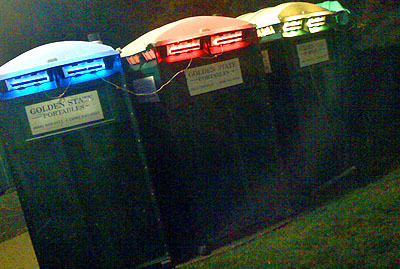
I was attending a function at the Goolge Plex last night and was amazed at just how far Google looks to push their brand experience. I would have to say that it was a first to see outhouses all alight with Google’s colors.
If the outhouses were following the brand palette, so was everything else: the bar and colors of cups they serve; the building decor; the snowcone colors; the lighting upon the wall. Google has shown great execution with their brand and obviously that attention to detail pours over into all facets of their business.
As for July 2007, Google is commanding a 64.4% market share of search (reported by Hitwise.) Not a bad run since September 1998 to have built up almost a 160B market cap.
While on Google, George Anders also has an interesting piece in the Wall Street Journal on Google’s ability to execute going forward. Just a snippit for your delight.
“History suggests that it is perilous to seek long-lasting inspiration from young companies when they are riding high. In the early 1980s, experts lauded People Express for developing an upbeat, winning approach to employee relations. Unfortunately, that couldn’t protect the airline from financial troubles and an eventual sale of the company on distressed terms.”
—Latham

As a New Yorker and someone who was in the Lincoln Tunnel when the first plane hit, a volunteer on Ground Zero two days after 9/11, I was sent this on a daily email and though it should be shared. The anniversary is coming up in less than a month and I will never forget what I saw. It changed my life and is part of the reason I ended up out here in Jackson. Launched today was the new logo and website for the 9/11 memorial. I found this online at mediabistro.com.
“The new name, logo and identity for the National September 11 Memorial & Museum have just been unveiled, along with plans for a traveling exhibition where the public will be invited to sign steel beams to be used in the construction of the new Memorial & Museum. The new website also launched today.
“We are building a national symbol that, like the Statue of Liberty, tells us something about who we are as Americans. The re-naming of this project to the National September 11 Memorial at the World Trade Center reflects this national scope,” Memorial & Museum President and CEO Joe Daniels said. “Every day, we continue to build momentum for this campaign, helping to ensure that the events of September 11th are told to future generations. We look forward to bringing this exhibition to cities around the country.”
As had been mentioned in a previous blog, branding is everywhere, it shapes us. Here is the new logo that shapes a world tragedy memorial. Its hard to believe it has an official look. But we need consistency, something that won’t piss people off and the squares represent the two towers disappearing. Its polite, it makes sense and is tasteful.
Take a look at the new site as well www.buildthememorial.org.
Its full of info, photos and an understanding.
—Julie
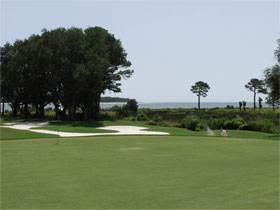
I strolled down to the beach last night hoping for a chance to see the Perseid meteor shower. It was not to be. Partly cloudy skies and the hazy, humid sub-tropical midsummer air obscured the view. No worries, though. I see plenty of meteors—shooting stars—throughout the year, especially in autumn and winter when the air doesn’t lie as heavily and the night sky over the ocean affords a more vivid artwork. So, walking northward along the shore, I otherwise entertained myself by occasionally dragging a toe across the ground to create a luminous line in the sand or, closer to the waterline, gently uncovering sanddollars and starfish all aglow in electric blue, both caused by the phenomenon of bioluminescent algae inhabiting our waters and washing ashore peculiar to this time of year.
In no time at all I had forgotten all about lights streaking across the sky. As it always happens during my frequent roams along this beach, I became engrossed in thought. This time, my thoughts were of my good fortune to be in such a place as Hilton Head Island. Unlike my high altitude colleagues out there in Jackson Hole, WY, I live barely above sea level in South Carolina’s Lowcountry region, a few steps from the gently rolling surf of the South Atlantic Bight. Like my colleagues, though, I am surrounded by astounding natural beauty and simple pleasures enjoyed rarely by most, but every day by me.
I thought of the visitors who comb the beach for seashells and other treasures so they can take a piece of “my” island back home with them, and those who thrill at the fleeting glimpse of a dolphin’s dorsal fin—just one of my neighbors—and I was thankful for the series of events that led me here on a whim seven years ago.
To the outside world, the Hilton Head experience is about golf (that’s me hitting out of trouble at Haig Point a few years ago) and vacation resorts, but those who live here see it in a very different light—and it is so much more than that.
—Frank

Last night around 9pm I had a sweet little moment after putting the kids to bed where I sat on the porch and appreciated the incredible view and solitude this place has to offer. The view, always inspiring, was made particularly appreciable by the color and shape of the clouds.
Just as I was deep in appreciation, I noticed a couple of cars drive by the house that were obviously not from around here (the California plates generally give them away). Now, the road I live on accesses an area in the Hole that has become very desirable, and there are quite a few “second homes” in the area. (It’s always funny to hear the second homeowners or the newly transplanted talk about how long they’ve been coming here, but that’s a whole other topic, and frankly, it doesn’t matter.)
I’ve seen a lot of sunsets—and sunrises for that matter—from this porch and have developed an intimacy with evening in that spot throughout the seasons. But it got me thinking about the familiarity one gets with a place after many years of watching the seasons go by, and I wondered about those second homeowners and their memories of passing seasons in the Hole. Do they only remember the prime summer or winter experiences, or do they develop an appreciation for the cold, wet and snowy times as well? Or do they simply head back to California, Texas or wherever when the Hole is not as nice a place to be? Of course, some do. And do they have a similar appreciation for the view from their porch in the place they call home? One can only hope they do, for without the appreciation of a place you call home—and that is special—what’s the point?
—Chris
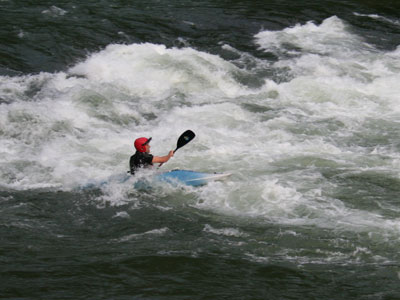
It’s been a while since I’ve been in my boat. But after two years of sitting under the porch collecting cobwebs (the boat, not me), I finally did it. It wasn’t for lack of interest, as I’ve certainly been wanting to go. But paddling—even here in Jackson Hole, where we have several great white-water stretches right in our back yard—can be difficult to find the time or line up with the right partner.
Mind you, I’m not making excuses, but it appears that living an engaged life often causes you to engage in so much that some things fall by the wayside. Could it be work? Could it be the major addition to our house in the past year-and-a-half that I was completely engrossed in? Perhaps the adoption of my youngest daughter from China last summer? Or maybe the fact that we now have two small children whom I really like to spend time with. It is a lot easier to get out for a kick-ass mountain bike ride for a couple of hours than to commit to half a day or more on the river—and more exercise, too. And then there’s my wife: a woman who’s fun-hog tendencies might very well surpass my own. (Remember, Compromise is arguably the most important of the “Four Cs” of marriage.)
Whatever it is, it sure felt good to be on the river again. Just a short after-work paddle, from Taco Hole down to Lunch Counter. But plenty enough to loosen up the hips, brush up on the roll, surf a bit, and cool off on a hot July day.
—Chris
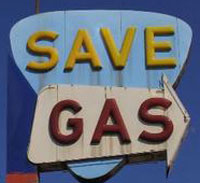
I’ve made a goal for myself to ride my bike to work twice a week for as much of the warmer months here in Jackson Hole as I can. This is not always an easy task, between weather, meetings, errands, carting kids around, etc. It’s also not as easy as riding from across town on a bike path—my ride from Wilson is a fifteen mile round-trip—but it sure feels good to get in the exercise and not have to sit in busy tourist traffic.
As you may know from previous posts, I’m a fan of Keith Peters’ Carbon Neutral Journal. Occasionally Keith writes some interesting things on his own findings about his driving and cycling experiences. (In fact, today’s post has to do with the greening of our US capital. I know, sounds far-fetched.)
So, in the spirit of carbon neutrality, I’ve realized some carbon and cost savings for my personal cycling goal—though exercise and sanity were at the root of my original goal.
I typically fill the tank in my van (admittedly not the most carbon-friendly vehicle, but hey, it gets 17+ miles per gallon and that’s better than a Hummer, right, Stine?) every two weeks. Figuring there are ten days of work commute in a typical two-week period and I ride my bike twice a week, in five weeks of two-day-a-week bike commutes I will have saved a whole tank of gas. That’s close to $70 per tank in today’s prices! Yeah, it’s a guzzler—all the more reason to feel good about riding the bike.
So, if you’ve been meaning to ride your bike to work more (or walk, or car-pool, or ride the bus—whatever), hopefully this provides a little incentive. And if not, well, at least keep an eye out for us cyclists on the road. Thanks!
—Chris
Here at Circumerro we’ve gotten pretty good at producing our products. But just when you think the job of producing is done, it’s time to market. While there are many ways to do that, direct mail and direct email marketing tend to be fairly straight forward and effective. And as we continue to focus more of our energies on the Web, we look to direct email marketing as the easiest and most cost-effective way to get the word out.
But here’s the catch (or at least one of ’em): email addresses tend to be hard to come by, while snail-mail addresses practically grow on trees. Of course, I completely understand the reluctance to provide email addresses in this age of unending spam. Many of us who work in front of a computer get literally hundreds of emails a day, and the average Internet user has something like four separate email accounts. If you work a lot with email and have an effective spam filter, most of those emails are qualified, necessary things. Unfortunately, in a less-than-perfect world, a great deal of email is unwanted spam.
Back to the point:
Sending snail mail costs money. You’ve got to print the piece and then pay to have it mailed, including the physical cost of handling the pieces so many times before they end up in your box. But to send something via email costs very little, for both the sender and the recipient. Mostly just some extra bandwidth and the time it takes to set it up. Of course, there’s the time on the recipient’s end to read the message, qualify it as something they want to respond to, and then hit delete if they’re not interested—arguably less time than it takes to check your snail mail box and throw the unwanteds in the trash (or hopefully the recycle bin).
The cost of direct snail mail marketing certainly gives marketers pause about the resources they are using (or should). But the system continues to encourage us to waste resources to deliver our messages effectively when email marketing creates no waste.
For as much as we hate to receive junk mail in our postal box, we still prefer it over unwanted email. For example, when I call my local chamber of commerce for their business listing, they are more than happy to share their members’ physical addresses with me, but the emails? That’s a big no-no.
It’s controversial enough that, when I floated it by my friend Keith for use in his CarbonNeutralJournal blog (as I do for many things I find on the subject of saving resources), he bounced it back to me, saying:
“I agree with your logic, but not with the reality. You can do a lot to curb print junk mail (Greendimes is just one such service), but you can’t do anything to stop junk email. Plus it’s often so vulgar and offensive.”
As a marketer I realize that much of what we produce in print is just so much fodder for the recycle bin (which is why we here at Circumerro focus our efforts on the Web when we can). It is very much a resource issue, and I hope we can get to a point where it’s more acceptable to receive email than snail mail.
Again, Keith sums it up:
“I’m afraid the spammers have spoiled the water for what could/should have evolved into an efficient and reasonably unobtrusive way to do direct marketing.”
Thanks for nothin’, spammers.
—Chris
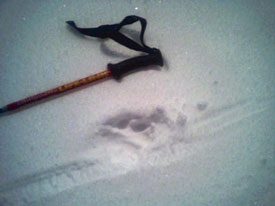
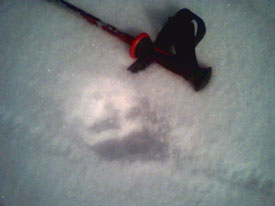
While neither of these pictures (taken with my cell camera) is the greatest, you get the impression this is no ordinary dog track.
It’s one thing to see animal tracks in the snow, but it’s another thing entirely to see the tracks of a large and rare predator.
A friend and I were taking advantage of some fresh, late-season snow and a beautiful day by getting a couple of runs in on a favorite backcountry stash south of Teton Pass. We were near the top of the climb when my friend noticed what we first thought were very large dog tracks coming down the top hundred feet or so of the skin track. The inch of new snow, slightly warmed by the sun, was the ideal medium to record the imprint. We wondered why a dog would be walking down this part of the hill without a human. It was apparent that we were the first two people on top that day; no one else had skinned up the track ahead of us or, after further investigation, from any other direction (there’s really only one approach to this spot and we were on it). And it was very obvious that these tracks were fresh—very fresh.
We noticed the tracks just above where it veered off to the southeast (the animal’s right). Once on top, we were able to follow the tracks across the top of the small peak. We observed where the animal had stopped to sniff around—after having followed a much smaller animal’s tracks for a few yards—and had come up from the west side of the hill completely unaccompanied by any other tracks—human or otherwise. While neither of us are trained animal trackers, both of us can profess some knowledge of indigenous animal tracks of the Tetons. We looked hard at some very good prints: we made note of the pad shapes and positions, the presence of claw marks, the apparent gait of the animal, and the very large size of the prints themselves. It was our combined, unprofessional opinions that these were indeed the tracks of a wolf.
After taking a couple of pictures with the camera on my cell phone (not the greatest, as you can see) and discussing the very real possibility of there being a wolf in this part of the southern Tetons, we skied some lovely, creamy spring snow.
My partner, being less than enamored with the skiing, decided to head out after that run. I, on the other hand, wanted to enjoy the beauty of the day and the spring conditions. I also wanted to get another look at those tracks and see where they went.
On my next skin up, and upon reaching the point where the wolf took sudden departure of the ridge toward the southeast, I could see clearly where it had headed across the glade just below. Funny thing though, we had looked for such a track not twenty minutes before and it was definitely not there. Upon closer inspection of the track, I realized that the animal must have been coming down the hill when it either heard or smelled us, stopped close enough to the edge of the ridge to take a look, and then took off in the opposite direction. It must also have then waited out of sight, just below the ridge, for us to pass and then continued across the glade.
This was a little freaky: having been in a wolf’s sights without us seeing it. We strive to be respectful of the nature around us as we engage in it, but this kind of encounter certainly gives one a renewed awe of and respect for the wildness that is so close around us here in the greater Yellowstone ecosystem. Seeing the animal would have been impressive, no doubt; but seeing only tracks and deciphering just what the animal had done only moments before is, in my mind, a much more valuable experience.
—Chris
